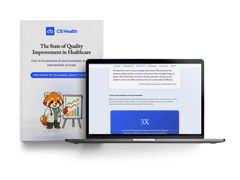
3 Hospital Quality Metrics That You Should Know
Hospital quality metrics are standards that measure the quality of healthcare services. They cover various aspects of hospital performance, such as effectiveness, safety, efficiency, and patient satisfaction. A recent study by the Centers for Medicare & Medicaid Services (CMS) found that only 10.4% of hospitals received the highest rating of 5 stars in overall hospital quality in 2022.
Measuring the quality of care in hospitals is crucial for achieving better patient outcomes. However, it's not an easy task to perform as hundreds of possible indicators can be used, but not all of them are relevant, reliable, or comparable. Choosing the most suitable metrics that reflect the goals and priorities of healthcare quality improvement is essential.
1. Survival Rate
It's important to understand that not every patient will survive, regardless of the interventions employed. The survival rate is the percentage of patients who survive a particular condition or medical procedure within a specific time.
This metric aims to increase the number of patients who survive through effective healthcare protocols and procedures within a hospital setting by highlighting the following factors:
- Effectiveness of healthcare interventions
- Accuracy of diagnosis
- Quality of treatment
- Adequacy of post-surgery care
A higher survival rate based on healthcare interventions within a hospital setting indicates better quality of care. A hospital's performance does not solely influence the survival rate but also the patient's characteristics and the nature of the disease, including the following:
- Age
- Gender
- Comorbidities
- Genetic predisposition
- Environmental exposure
How to Improve Survival Rates
Hospitals should implement evidence-based strategies to improve clinical care and boost the survival rate. These include following the best practices for each indicator, conducting a gap analysis, and developing an implementation plan.
To monitor the progress and sustainability of improvements, hospitals should use a quality management dashboard that displays key performance indicators, such as:
- Mortality
- Safety of care
- Patient experience
- Hospital readmission rate
- Timeliness and effectiveness of care
Hospitals can enhance their quality of care and patient safety by tracking and improving survival rates.
2. Patient Adherence to Regimens
Patient adherence to regimens measures how well patients follow their prescribed medication, diet, exercise, and other recommendations from healthcare providers.
High patient adherence not only signifies that individuals are taking an active role in managing their health, but it also results in better health outcomes and reduces overall healthcare costs. This is because tracking the adherence metric allows hospitals to identify gaps and initiate targeted interventions to sustain outcomes better.
Adherence to medication regimens may seem easier to enforce and measure in hospitals because healthcare providers, such as nurses, are responsible for administering medications directly to patients; however, this is not always the case. Most medication is self-administered at home, which opens the door to a number of problems.
Non-adherence to medical treatments incurs huge costs for individuals and society. In the United States alone, it leads to an estimated 125,000 preventable deaths each year due to cardiovascular diseases. Additionally, optimized medication therapy can help save more than $500 billion in healthcare expenses.
How to Improve Patient Adherence to Regimens
Nothing less than a comprehensive, patient-centered approach to addressing these factors and barriers is required. Strategies include the following:
- Simplifying the regimen
- Providing clear instructions
- Using reminders
- Involving family support
- Enhancing patient-provider relationships
- Tailoring interventions
- Monitoring and feedback
» Here's how to leverage effective strategies for knowledge management
3. The Right Staff Mix to Fulfil the Required Roles
This metric refers to the optimal combination of staff members with different skills, qualifications, and experience to deliver high-quality and efficient healthcare services. Methods like nursing staff ratios fail to account for how sick the patients are, which is a serious gap.
A staffing ratio that does not consider patient acuity may lead to under-cared patients and staff burnout due to overworked nurses.
"I have been in an intensive care unit where I had six critically ill patients, exceeding the appropriate staff-to-patient acuity ratio. On a medical-surgical floor, I was assigned 45 patients, well beyond the capacity for one nurse to deliver quality care based on the patient's needs."
While finding the right staff mix is crucial for hospitals to achieve their goals and objectives, it is not easy, particularly regarding talent shortages, skill gaps, and workforce diversity. In 2021, the World Health Organization (WHO) projected a global shortage of 10 million health workers by 2030.
How to Improve Your Staff Mix
Hospitals should require flexible staffing models that cater to changing patient needs, worker availability, and effective collaboration among healthcare professionals. Such models must also adapt to patients' varying acuity and healthcare workers' competencies, ensuring the right diverse mix of experienced leaders and teachers alongside younger employees and learners.
By finding the right mix of staff, several quality-focused aspects of your hospital could be improved, including the following:
- Reduced errors
- Increased efficiency
- Improved patient outcomes
- Fostered innovation and learning
- Enhanced staff satisfaction and productivity
» Optimize care with the power of data-driven decision making
How to Effectively Utilizing Hospital Quality Metrics
Evaluate Outcomes, Not Checklists
Rather than simply checking boxes, providers should analyze each metric's impact on patient care. Measures showing treatment responses carry more weight than those focused solely on process completion. The emphasis must shift from basic measurement to evaluating tangible value.
Eliminate Non-Value-Added Tasks
Unnecessary tasks that consume resources without benefiting patients should be eliminated. For example, hourly blood pressure checks may not always provide meaningful insights yet require significant staff and patient time. Prioritize engaging patients and observing responses to gain critical health insights.
Having an effective knowledge management system in place can help clinicians identify which tasks are crucial to patient success and which are unnecessary, alongside improving adherence to best practices. Learn more about this with C8 Health's features.
Prioritize Outcomes Over Processes
Modern metrics should highlight patient outcomes, not just document process steps. Therefore, capture data tied to care efficacy and value to identify improvement areas and drive targeted enhancements. Outcome-focused metrics are far more focused on quality and patient experience, continuously evaluating and advancing patient care.
» Learn how to streamline information to boost patient care
Balancing Metrics and Empathetic Care
Historically, metrics centered on verifying process completion, not care improvement. Today's metrics meaningfully focus on patient outcomes over process adherence alone.
While monitoring quality may increase adherence to best practices in healthcare, empathetic, high-quality care must remain the priority. Environments lacking empathy undermine healthcare's purpose. Combining outcome-driven approaches with compassionate care improves treatment results and experiences.
Understand the implications behind measures, not just data recording. Comprehending patient responses and adapting care accordingly provides far more value. Healthcare should foster an environment where patients thrive, not just survive.


